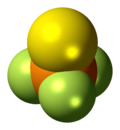Thiophosphoryl fluoride
|
|
|||
| Names | |||
|---|---|---|---|
|
IUPAC name
Trifluoro(sulfanylidene)-λ5-phosphane
|
|||
| Other names
Phosphorothioc trifluoride, Phosphorothioic trifluoride, Phosphorus fluoride sulfide, Phosphorus sulfurtrifluoride, Phosphorus thiofluoride, Thiophosphoryl trifluoride, Trifluorophosphine sulfide, trifluoro-λ5-phosphanethione
|
|||
| Identifiers | |||
|
3D model (JSmol)
|
|||
| ChemSpider | |||
|
|||
|
|||
| Properties | |||
| PSF3 | |||
| Molar mass | 120.035 g/mol | ||
| Appearance | Colorless gas or liquid | ||
| Density | 1.56g/cm3 liquid 4.906 g/L as gas | ||
| Melting point | −148.8 °C (−235.8 °F; 124.3 K) | ||
| Boiling point | −52.25 °C (−62.05 °F; 220.90 K) | ||
| slight, Highly reactive | |||
| Structure | |||
| tetrahedron; | |||
| Hazards | |||
| Main hazards | Spontaneously flammable in air; toxic fumes | ||
| Flash point | very low | ||
| Related compounds | |||
|
Related compounds
|
Phosphoryl trifluoride Phosphorus trifluoride Thiazyl trifluoride PSeF3 Thiophosphoryl chloride |
||
|
Except where otherwise noted, data are given for materials in their standard state (at 25 °C [77 °F], 100 kPa).
|
|||
| Infobox references | |||
Thiophosphoryl fluoride is an inorganic molecular gas with formula PSF3 containing phosphorus, sulfur and fluorine. It spontaneously ignites in air and burns with a cool flame. The discoverers were able to have flames around their hands without discomfort, and called it "probably one of the coldest flames known". The gas was discovered in 1888.
It is useless for chemical warfare as it burns immediately and is not toxic enough.
Thiophosphoryl fluoride was discovered and named by J. W. Rodger and T. E. Thorpe in 1888.
They prepared it by heating arsenic trifluoride and thiophosphoryl chloride together in a sealed glass tube to 150 °C. Also produced in this reaction was silicon tetrafluoride and phosphorus fluorides. By increasing the PSCl3 the proportion of PSF3 was increased. They observed the spontaneous inflammability. They also used this method:
at 170 °C, and also substituting a mixture of red phosphorus and sulfur, and substituting bismuth trifluoride.
Another way to prepare PSF3 is to add fluoride to PSCl3 using sodium fluoride in acetonitrile.
A high yield reaction can be used to produce the gas:
P4S10 + 1 2HF → 6 H2S + 4 PSF3
Under high pressure phosphorus trifluoride can react with hydrogen sulfide to yield:
Another high pressure production uses phosphorus trifluoride with sulfur.
PSF3 is decomposed by moisture and oxygen or heat. With heat, phosphorus, sulfur and phosphorus fluorides are formed:
The hot gas reacts with glass producing SF4, sulfur and elemental phosphorus. The pure gas is completely absorbed by alkali solutions. However, it does not react with ether, benzene, carbon disulfide, or pure sulfuric acid. It is stable against CaO, which can be used to remove impurities such as SiF4 and PF3. In air it burns spontaneously with a greyish green flame, producing solid white fumes. With dry oxygen combustion may not be spontaneous and the flame is yellow. On burning SO2 and P2O5 are produced. The gas burns with one of the coldest flames known.
...
Wikipedia


